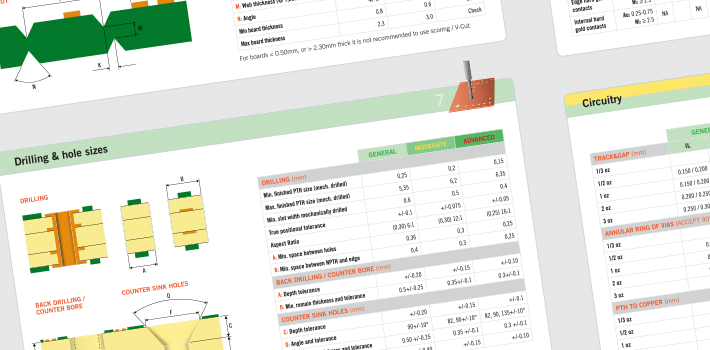Producing reliable PCBs for electronic defense applications means producing PCBs with high technical performance with a tolerance for extreme harsh environments. There are also several rules and regulations that the product and manufacturing process need to be compliant to. We have talked to some of our NCAB experts regarding what to think about when producing reliable PCBs for the defense industry.

When buying and manufacturing PCBs for the defense industry, everyone in the entire supply chain needs to follow a number of rules, regulations and laws in order to get permission to do this. USA, EU and NATO have different rules, while some are applicable to several markets. Included in this are also different types of export licenses that are needed to export printed circuit boards to different countries. It is not only the compliance to the regulations that needs to be covered, the set up within the organization is equally important. It´s necessary that the PCB supplier is large enough to have the possibilities and knowledge to support and control the factories and all parties involved.
What is export control regulations?
“Export controls is a far-reaching topic that covers many things. The scope of these laws can be very broad and may restrict and regulate more than just the technical data. Everyone in the supply chain is responsible for complying with laws and regulations that govern export controls, and responsible for knowing that your customer and your supplier are legally authorized to have access to the export-controlled item or service. In order to protect your company’s and your customer’s interests, it is important to partner up with a supplier that understands and adheres to export control regulations,” says David Duross, Quality Manager and ITAR Compliance Officer at NCAB Group USA.
ITAR, DFAR, EAR – what do they mean?
When dealing with PCBs for the defense industry in the USA, there are regulations like ITAR, EAR and DFAR which you need to be compliant with. David Duross describes them and their purposes.
“ITAR (International Traffic in Arms Regulations) is one of two US export regulations intended to restrict and control defense and military related technologies and services listed on the US Munitions List (USML). ITAR and other export control regulations exist to protect national security and to prevent technology from falling into the wrong hands. Failure to adhere to the export controls can result in criminal prosecution resulting in fines and incarceration. ITAR-controlled PCBs are allowed to be manufactured outside the United States provided certain criteria is met and that legal authorization is granted by the US Department of State.”
“It is important to partner up with a supplier that understands and adheres to export control regulations”
David Duross,
Quality Manager and ITAR Compliance Officer
NCAB Group USA

“We deal daily with ITAR and EAR questions. EAR (Export Administration Regulation) is the other US export regulation that applies to anything not restricted and controlled by the ITAR. Anything explicitly restricted and controlled under the EAR shall have an Export Control Classification number (ECCN) assigned to that item or service”, David continues.
“And then there is DFAR (Defense Federal Acquisition Regulation) which is also important to have knowledge about. It is a set of US government regulations that govern the way the Department of Defense (DOD) acquires goods and services from Prime Contractors. A prime contractor is responsible for complying with DFAR clauses specified in their contracts with the DOD. The prime contractor is responsible for passing DFARs down to their second-tier subcontractor. Failure to follow some DFARs that flow down through the supply chain can result in early termination of the contract”.
What is export?
As used in the context of export controls, the term “export” covers a broad range of activities that include the export of products, services or information. In general, an export occurs when there is any transfer to any non-U.S. person, either within or outside of the U.S., of controlled commodities, technology, or software, by physical, electronic, oral, or visual means, with the knowledge or intent that the items will be shipped, transferred, or transmitted outside of the USA. (source: DEC)
What to think about when doing business with other countries for example in Europe?
In Europe, regulations from NATO, the EU, and individual countries dictate the principles of export, data security, and supplier selection. The process involves adhering to these rules, declaring exports, and ensuring compliance with all relevant regulations.
For example, countries like the UK, Singapore, and Germany require specific information to authorize the export of military goods. This process results in the issuance of an export license, which grants the right to export the goods under a license number. Properly declaring goods in accordance with country-specific regulations is crucial. However, it’s important to note that export licenses are not always required for PCBs, depending on the country; some may regulate specific types of PCBs while others do not.
What do you need to do to get an export license?
When working with export licenses, specific information on the PCBs is required to ensure compliance with the correct export regulations. It is crucial to adhere to the law, demonstrate due diligence, and evaluate associated risks. For all export control of military products, the information needed can vary from country to country, and generally includes:
- Product Name / Part No:
- Is the PCB designed for use in a military product or system?
- Is the PCB intended for “Dual use” – a commercially available product that has been “modified for military use”?
- Is the PCB a component intended for use in connection with development, production, handling, operation, maintenance, storage, identification, or dissemination of chemical, biological, or nuclear weapons or other nuclear explosive devices, or the development, production, maintenance, or storage of missiles capable of delivering such weapons.
- What will the PCB be incorporated into?
- What function or part will it be used for?
- Who and where will it be assembled?
- Who and where is the consignee?
This information will help to determine the ML classification and the right license to use. Some of the export licenses are restrictive on the list of goods or country to export to.
Is it both the PCB supplier and the factories that need to be compliant to the regulations?
It is crucial that customers inform us if their products are related to defense. We must then notify our suppliers that the products are for defense purposes, and our suppliers must handle the order accordingly. We have an obligation to understand the intended use of our products, be able to declare them as defense products when applicable, and recognize when they are not.
How can customers feel safe buying defense PCBs from NCAB?
We have experience handling these types of PCBs and related questions. The process involves securely transferring Gerber files, managing all data through a dedicated system, and supporting our factories with our Factory Management teams in Taiwan, the US, and Europe to ensure proper export control. Our Factory Management staff receive regular training on these matters, and we also provide education across the entire NCAB Group to ensure that each local office has qualified experts who are up-to-date with their specific local regulations and restrictions.
Currently, NCAB has approved factories in the UK, EU, USA, and Taiwan that are compliant to the defense regulations. For ITAR, we have factories in the USA and Taiwan.
How do I know that my PCB order is covered by ITAR, EAR or DFAR?
“What regulations (ITAR, EAR and DFAR) are applicable depends on where the PCB is designed and in what type of application it will be used. There are some rules that applies to the different types of applications,” explains Jan Pedersen, Technical Director at NCAB Group
“The result of being noncompliant with any of the rules, standards and provisions can be quite serious”
Jan Pedersen, Director of Technology
NCAB Group

Are there any specific requirements when designing PCBs for the defense industry?
Military Grade PCB require high reliability with long service times under extreme conditions. PCBs for military applications such as aviation, ground activities, defense, naval applications, and space weapons requires a wide range of materials, composites, and construction. The general rule for a PCB design is to meet IPC class 3 requirements, which means the design shall also meet IPC-2220 sectional standards for PCB design.
What are the standards to be aware of?
“MIL-PRF-31032 is a performance specification; in other words, it was established to test PCBs to certify that they meet the necessary requirements for military use”, says Jan Pedersen.
“This specification intends to allow the device manufacturer the freedom to enact best commercial practices while still delivering products that meet military performance needs. Certification to this standard is intended for manufacturers of the kinds of devices mentioned above that wish to be suppliers to the Department of Defense. To deliver, the factory needs to be certified to MIL-PRF-31032. To become certified, a company must submit a formal request to the Department of Defense for a certification audit.
“In general MIL-PRF-31032 requires IPC class 3 design and performance, but MIL–PRF–31032/3 replaces IPC-6011 series test Frequency and Performance Requirements. In addition, MIL-PRF-31032 is stringent on external visual requirements, but basically in line with NCAB PCB Specification”, Jan continues.
“The Allied Quality Assurance Publications (AQAP) are standards for quality assurance systems developed by NATO”, says Jan. “The aim of the AQAP agreement is to define standards for quality assurance of defense products. These standards are an integral part of contracts awarded in the military field involving NATO member countries. AQAP documents are therefore important to contractors and companies wanting to bid for such contracts. For a PCB supplier, compliance to AQAP 2110 – NATO Quality Assurance Requirements for Design, Development and Production-, is required”.
Noncompliance to the rules – what will happen?
“The result of being noncompliant with any of the rules, standards and provisions can be quite serious. It can mean the shipment will be stopped in export customs, the forwarder can decline to carry the goods, the goods can be stopped in import customs, and finally the customer can be forced to decline receipt”, says Jan Pedersen.
“If we break the technical rules of our customer, the defense contractor have all rights to reject the goods delivered. The worst a PCB supplier can do is to pretend ignorance. In the defense industry ignorance is not acceptable. We SHALL know what we do when we accept orders from a defense related company, or from an EMS when the end customer is known. This is exactly why NCAB is continuously monitoring standards, regulations and rules that is applicable to the defense industry. Being a reliable partner with sufficient knowledge to all these rules is a safety for our customers”, Jan Pedersen finishes off.
Want to know more about PCBs for the defense industry?

PCB design tools
For more advice about PCB design or applications of PCBs, we
have different PCB tools that can be downloaded for free.
